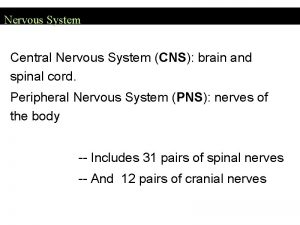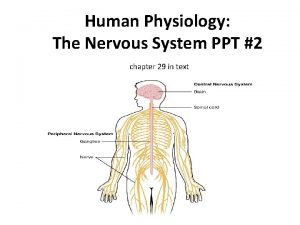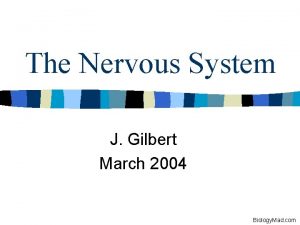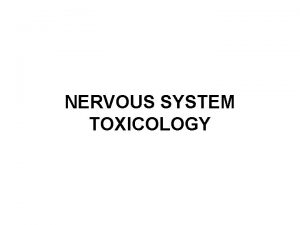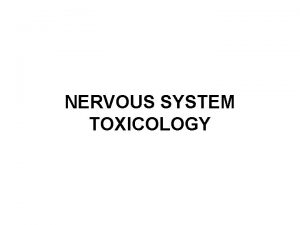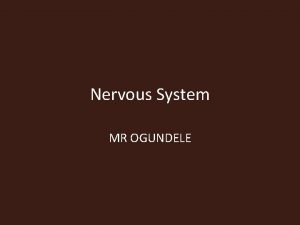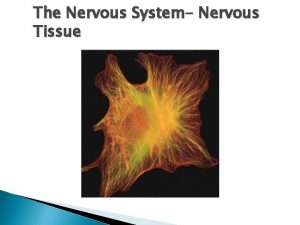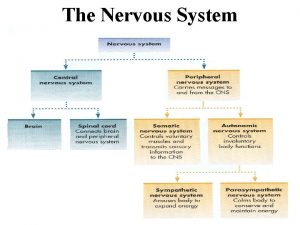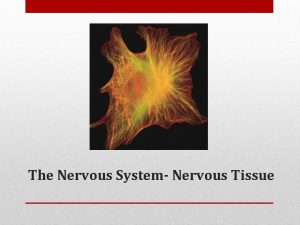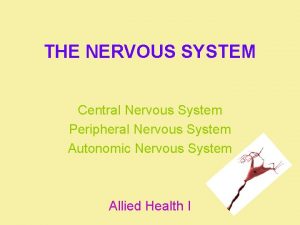THE NERVOUS SYSTEM HUMAN NERVOUS SYSTEM Main control
































- Slides: 32

THE NERVOUS SYSTEM

HUMAN NERVOUS SYSTEM • Main control centre for the body • Tells body parts how and when to do everything • Divided into 2 parts: 1. Central Nervous System (CNS) • Brain and spinal cord 2. Peripheral Nervous System (PNS) • All other NS parts – nerves and sensors



NERVOUS SYSTEM DIVISIONS • Link to Page


4 MAIN FUNCTIONS OF THE N. S. • Reception – CNS taking in information about the environment • Interpretation – making sense of the environmental information • Sorting – deciding what information needs to be dealt with first and which needs to be ignored • Transmission – sending out a message to tell a certain reaction to occur

NEURONS • Another name for a nerve cell • Carry impulses (information) to and from the CNS • A nerve is a bundle of neurons • 3 main types of neurons • Sensory • Association • Motor

SENSORY NEURON • Part of the PNS • Sends impulses from sensory organs to the CNS • Ex: ears, nose, mouth, skin • Can regenerate • Due to neurilemma • Protected by myelin sheath • Cell body is off to the side

http: //www. biologymad. com/nervoussyste m/sensoryneurone. jpg

ASSOCIATION NEURON • aka: Interneurons or Relay neurons • Located in the CNS only • CNS determines what to do • Send impulses from sensory to motor neurons • Cannot regenerate • No sheath to protect it • Cell body at the end of the neuron

http: //www. biologymad. com/nervoussyste m/relayneurone. jpg

MOTOR NEURON • Part of the PNS • Sends the message from the association neuron to the muscle, organ or gland in question • Can regenerate • Due to neurilemma • Protected by myelin sheath • Cell body at the end of the neuron

http: //s 3. hubimg. com/u/5095586_f 520. jpg

PATHWAY OF INFORMATION FLOW Example – you are driving a car • Reception: Eyes see a stop sign • Transmission: Sensory neuron delivers information to the CNS • Interpretation & Sorting: Association neurons in the CNS decide what to do • Transmission: Motor neuron sends message to your legs/ feet to put on the breaks/stop the car

SENSORY NERVE ENDINGS IN THE SKIN • Your skin contains different receptors • Different receptors in skin can sense • Touch • Pressure • Heat • Pain • Cold


ANATOMY OF A NEURON • Cell body • A mass of neuroplasm at the top or side of the neuron which contains the nucleus and dendrites • Dendrites • Extensions of the cell body which receive impulses from another neuron and direct them to the cell body

ANATOMY OF A NEURON (CONT’D) • Axon • Extends away from the cell body, takes the impulse towards the next neuron or affecter • May or may not have a myelin sheath • Schwann cell • Raps around the axon (like a jelly – roll) and secretes the myelin sheath

ANATOMY OF A NEURON (CONT’D) • Neurilemma • Membrane surrounding the myelin sheath in motor and sensory neurons • Provides the ability of regeneration and repair of the neurons • Myelin sheath • Fatty white substance on motor and sensory neurons • Act as an insulator to prevent ion loss and increase speed of the nerve impulses

ANATOMY OF A NEURON • Node of Ranvier • Gap in the myelin sheath • Gives a boost to passing nerve impulses • It allows the impulse to escape and jump across parts of the axon

ADD THESE TO THE BOTTOM OF YOUR PAGE • Synapse - Area in between one neurons’ axon and another neurons’ dendrites • Ganglion - a group of cell bodies • Nerve - a bundle of axons. Can be sensory, motor or mixed nerves • Synaptic Endings – also called boutons – knobs at the end of an axon. Contain sacs called synaptic vesicles that produce and release chemicals called neurotransmitters.

C & C NEURONS – CHART – PAGE 9 • Based on: • Location (In CNS or PNS) • Myelination (yes or no) • Position of Cell body (end or side) • What the cell body looks like (dendrites all around it? ) • Regeneration possible (yes or no) • Function (what it delivers info to/from) • Length of axon (short or long)

C & C AXONS AND DENDRITES • 3 points per section (not bottom statement) • Due at end of class (or tomorrow) • Use the information from the diagrams and pages 5 & 9 to help you

DIAGRAM LABELLING • See overhead

ANSWER KEY FOR COMPARE AND CONTRAST


PARTS OF A NEURON REVIEW – ANSWERS 1. 2. 3. 4. 5. 6. 7. Bouton Schwann Cell or Myelin Axon Nodes of Ranvier Cell Body Dendrite Nucleus

EXTRA SLIDES • I do not use the next several slides

PERIPHERAL NERVOUS SYSTEM • Made up of two parts • Somatic Nervous System (SNS) • Voluntary control • Walking, talking • Input from sense organs i. e. ears, skin etc… • Output to skeletal muscle • Made of motor and sensory nerves • Cranial – to and from brain • Spinal – to and from spinal cord

AUTONOMIC NERVOUS SYSTEM • Sympathetic • Flight or fight • Speed functions up • Parasympathetic • Rest and digest • Slows functions down

PERIPHERAL NERVOUS SYSTEM • Autonomic Nervous System (ANS) • Involuntary • Controls heartbeat and breathing • Input from internal receptors • Output to smooth muscle/ glands • Made of motor and sensory nerves • Breaks into two parts • Sympathetic • Parasympathetic
 Neuronal pools
Neuronal pools Fundamentals of the nervous system and nervous tissue
Fundamentals of the nervous system and nervous tissue Processes of a neuron
Processes of a neuron Somatic and autonomic nervous system
Somatic and autonomic nervous system Brain parts
Brain parts Brain layer
Brain layer The human nervous system biology mad
The human nervous system biology mad Nervous system and digestive system
Nervous system and digestive system Endocrine system vs nervous system
Endocrine system vs nervous system Nervous system vs endocrine system venn diagram
Nervous system vs endocrine system venn diagram Endocrine system and nervous system
Endocrine system and nervous system Will future
Will future What is the central idea of this passage?
What is the central idea of this passage? Void main int main
Void main int main Hình ảnh bộ gõ cơ thể búng tay
Hình ảnh bộ gõ cơ thể búng tay Frameset trong html5
Frameset trong html5 Bổ thể
Bổ thể Tỉ lệ cơ thể trẻ em
Tỉ lệ cơ thể trẻ em Voi kéo gỗ như thế nào
Voi kéo gỗ như thế nào Tư thế worm breton là gì
Tư thế worm breton là gì Chúa yêu trần thế alleluia
Chúa yêu trần thế alleluia Môn thể thao bắt đầu bằng từ đua
Môn thể thao bắt đầu bằng từ đua Thế nào là hệ số cao nhất
Thế nào là hệ số cao nhất Các châu lục và đại dương trên thế giới
Các châu lục và đại dương trên thế giới Công thức tính thế năng
Công thức tính thế năng Trời xanh đây là của chúng ta thể thơ
Trời xanh đây là của chúng ta thể thơ Mật thư anh em như thể tay chân
Mật thư anh em như thể tay chân Làm thế nào để 102-1=99
Làm thế nào để 102-1=99 Phản ứng thế ankan
Phản ứng thế ankan Các châu lục và đại dương trên thế giới
Các châu lục và đại dương trên thế giới Thể thơ truyền thống
Thể thơ truyền thống Quá trình desamine hóa có thể tạo ra
Quá trình desamine hóa có thể tạo ra Một số thể thơ truyền thống
Một số thể thơ truyền thống




